
Полная версия
Plant Solutions
Biennials beneficial to wildlife
Lunaria biennis
Honesty Hardy biennial or annual
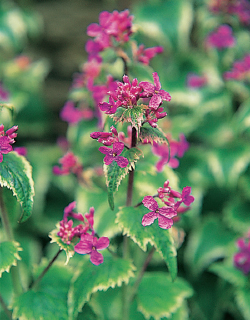
Toothed, heart-shaped green or variegated foliage with soft, fast growing stems, in spring, which produce sprays of four-petalled flowers in magenta, white or dark purple. The flat, rounded, transparent seedheads are pretty in late summer, but are easily damaged by wind. Attracts bees and butterflies; food for the Orange Tip butterfly.
Soil preference: Any
Aspect: Any
Season of interest: Spring, summer
Height and spread: 90cm × 45cm (3ft × 1ft 6in)
Companion plants: A pretty woodlander to naturalize in dapple shade among bluebells, red campion and species tulips.
Primula elatior hybrids
Polyanthus Hardy perennials grown as biennials
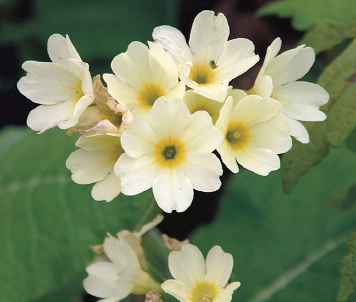
Very close relative of primroses and cowslips, these are the colourful hybrids whose oblong, wrinkled leaves form winter rosettes from which spring stems or ‘scapes’ topped with clusters of fragrant, five-petalled flowers in shades of yellow, blue, pink, red or white. Valuable to early bees, especially bumble bees. ‘Crescendo’ series are large-flowered; ‘Guinevere’ has dark leaves and pale flowers.
Soil preference: Moist but well-drained. Fertile
Aspect: Part shade
Season of interest: Spring
Height and spread: To 25cm × 25cm (10in × 10in)
Companion plants: Usually bedded when grown as biennials and excellent with tulips or with wall flowers. Yellow or red series look fine with blue forget-me-nots.
Verbascum bombyciferum
Giant Mullein Hardy biennial
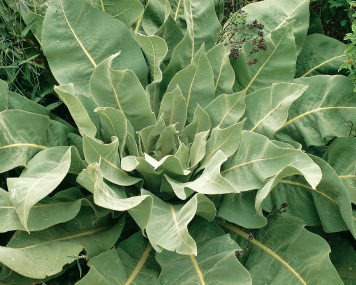
Huge rosettes of downy, pale grey leaves develop in the first year, followed in the second summer by towering, white felted flower spikes which are furnished for months with chrome yellow flowers. Food plant of the Mullein moth caterpillar; flowers attractive to bees.
Soil preference: Any free-draining
Aspect: Sun
Season of interest: Year round
Height and spread: 2.5m × 1.5m (7ft 6in × 4ft 6in)
Companion plants: One for bringing drama to a dry border. Try with airy grasses, or with other large, drought tolerant perennials such as Crambe cordifolia or Colquhounia coccinea.
Echium pininana
Tower of Jewels, Pride of Tenerife, Tree Echium Tender biennial

A bizarre giant bugloss from the Canary islands. Bristling, thick stems with narrow leaves extend during summer and carry thousands of small, violet blue or pinkish-tinged flowers. May take more than a year to reach flowering size, but always dies after flowering. Loved by bees.
Soil preference: Any free-draining
Aspect: Sun
Season of interest: Summer
Height and spread: 3m × 1m (10ft 9in × 3ft 3in)
Companion plants: Grown as a curio, but handsome when the flower stem begins to rear up amongst plants in a Mediterranean style border.
Salvia argentea
Hardy biennial or short-lived perennial
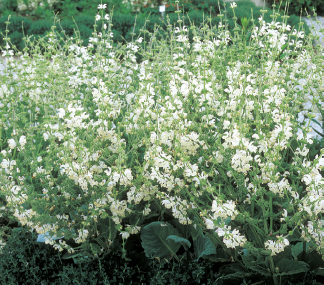
Large, oval, densely felted foliage forms large, flat rosettes from early summer. The small, greenish white, lipped flowers are held on branched stems which are square in section. A free self-seeder but young plants are susceptible to water logging, especially in winter. Loved by bees, butterflies and adult hoverflies.
Soil preference: Any free-draining
Aspect: Sun
Season of interest: Summer
Height and spread: 45cm × 45cm (1ft 6in × 1ft 6in)
Companion plants: The broad leaves contrast sharply with the small, spiky stems and foliage of rosemary, lavender and Russian sage (Perovskia)
Rudbeckia hirta
Half hardy biennial or short-lived perennial
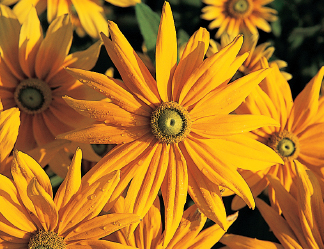
Oval, pointed leaves and somewhat hairy, branched stems bear, during late summer and autumn, big daisy flowers whose prominent central cones are usually dark and whose outer ray florets are broad, long and richly coloured in yellow, orange, mahogany or combinations of these hues.
Soil preference: Fertile, well-drained but moisture retentive
Aspect: Sun or part shade
Season of interest: Late summer and autumn
Height and spread: Variable to 1m × 45cm (3ft 3in × 1ft 6in)
Companion plants: Bright companions for red salvias or among cooler blues and mauves of autumn-flowering asters. Also useful for late bedding schemes.
Biennials for scent
Dianthus barbatus
Sweet William Hardy annual or short-lived perennial
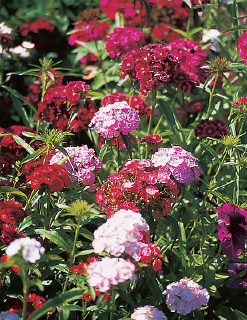
Member of the pink family, its branching stems furnished with broad or narrow dark green or purple-bronze leaves, are topped with clusters of flowers. The sepals are narrow and extended like little green beards. The fragrant blooms are maroon, red, pink, white or bicoloured and last for several weeks.
Soil preference: Any free-draining
Aspect: Sun
Season of interest: Early to midsummer
Height and spread: To 60cm × 45cm (2ft × 1ft 6in)
Companion plants: Great favourite for cottage planting and good company for annuals such as larkspurs and cornflowers, or to grow at the feet of climbing or bush roses. Also prized as a cut flower.
Viola x williamsii ‘Bedding Supreme’
Miniature pansy Hardy biennials or short-lived perennials

Seed-raised selections of small-flowered pansies or violas with honey-scented, five-petalled flowers produced above lobed leaves. short-lived as perennials, but can be kept in flower for months by regular deadheading. Good series: ‘Bedding Supreme’ comes in a broad colour mix, ‘Singing in the Blues’ in shades of purple, violet and blue.
Soil preference: Any free-draining but not too dry
Aspect: Sun, part shade
Season of interest: Winter, spring, summer
Height and spread: 20cm × 30cm (8in × 12in)
Companion plants: Like all pansies and violas, these plants fit anywhere with anything. Lovely in a cottage border, seeding among pinks, antirrhinums or in semi-shade with small dicentras or between polyanthus.
Matthiola incana
Stock, Brompton Stock Biennial
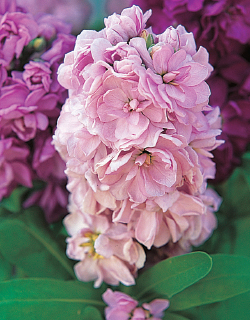
Glaucous, slightly downy, grey-green foliage which produces multiple short stems, or long single stems bearing highly fragrant single or double blooms in white or shades of violet, mauve or pink. Cutting varieties include Ten Week stocks, but the wild species is attractive for cottage garden use. Excellent bee plant.
Soil preference: Any free-draining
Aspect: Sun
Season of interest: Summer.
Height and spread: Variable to 1m × 20cm (Variable to 3ft 3in × 10in)
Companion plants: Once popular for overwintered bedding, Brompton Stocks are more frequently used to dot among early summer mixed borders, preludes to pinks or border carnations, or to grow among bush roses.
Biennials with distinctive foliage
Onopordon nervosum
Scottish Thistle Hardy biennial
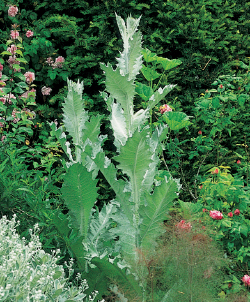
R. Coates
Metallic, silvery-grey leaves form dramatic rosettes in autumn and thick, winged, branched stems rear up during spring and summer, creating tree-like structures decorated in summer with purplish red thistle flowers. Viciously armed in all its parts. A prolific self-seeder.
Soil preference: Any free-draining
Aspect: Full sun
Season of interest: All year, mainly summer
Height and spread: Up to 3m × 1.5m (10ft 9in × 4ft 6in)
Companion plants: Their architectural shape make these ideal plants for providing dramatic summer statements, particularly among soft outline perennials such as cranesbills. Also excellent in sparse gravel planting.
Lychnis coronaria
Rose Campion Hardy biennial
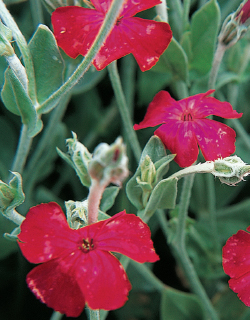
Loose rosettes of oval, felty, grey leaves develop in the first year. Branched, erect stems develop during the second spring and in summer carry a long succession of bright cerise, disc-shaped flowers. The form ‘Alba’ has white flowers which age to pale pink, whereas the petals of ‘Atrosanguinea’ are blood red.
Soil preference: Well-drained
Aspect: Sun
Season of interest: Summer
Height and spread: 1m × 50cm (3ft 3in × 1ft 8in)
Companion plants: A free self-seeder, which is lovely dotted about among the more rigid spikes of lupins or to harmonize with lavenders and Perovskia.
Silybum marianum
Our Lady’s Milk Thistle, Blessed Thistle Hardy biennial
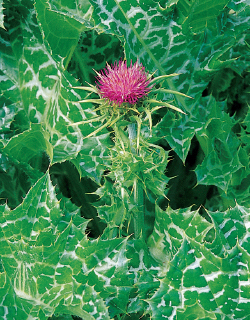
Heather Angel
Dark green, undulating, prickly leaves, each marbled with white streaks, form a loose-knit groundcover during spring. Flower spikes develop in summer producing deep purple thistle flowers, but the value is in the foliage. The name arises from the legend that the Blessed Virgin Mary dripped milk onto the leaves. Watch for slugs and snails.
Soil preference: Any well-drained
Aspect: Sun or part shade
Season of interest: Summer
Height and spread: 50cm × 1m (1ft 8in by 3ft 3in)
Companion plants: Valuable for linking spring with summer and lovely among early flowering perennials such as lupins, early poppies and perennial wallflowers.
Other good biennials
Trifolium rubens
Hardy biennial
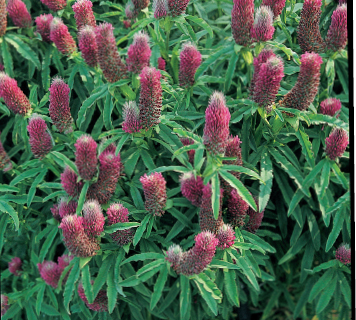
Heather Angel
A compact, bushy clover with typical three-lobed leaves and, during summer, elongated, slightly furry buds which open to produce tight groups of crimson flowers. An excellent cut flower and extremely bee-friendly. Like all legumes, the plant fixes its own nitrogen from the atmosphere.
Soil preference: Any free-draining
Aspect: Sun or part shade
Season of interest: Summer
Height and spread: 45cm × 20cm (18in × 8in)
Companion plants: A plant to blend harmoniously with the annual hare’s foot grass, Lagurus ovatus, whose flowers are similar in shape, but contrast in colour. Also good in a mixed border, to fill gaps between later flowering perennials.
Trifolium incarnatum
Italian Clover, Crimson Clover Annual or biennial plant
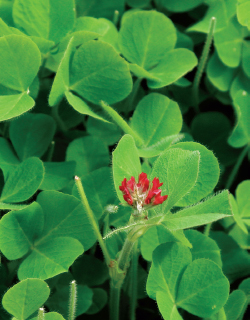
A vigorous annual or biennial whose young foliage is vivid emerald green. The three-lobed leaves form a neat mound during autumn followed, in late spring, by a succession of waving stems topped with oblong clover flowers in bright claret red. Not suitable for autumn sowing where winters are hard.
Soil preference: Any free-draining
Aspect: Sun
Season of interest: Summer
Height and spread: 60cm × 30cm (2ft × 1ft)
Companion plants: Valuable as a green manure, to be dug in before seeds are set, but also highly decorative among annuals or dotted among sun-loving Mediterranean shrubs such as Cistus, Artemisia and Helichrysum.
Dianthus chinensis
Hardy biennial
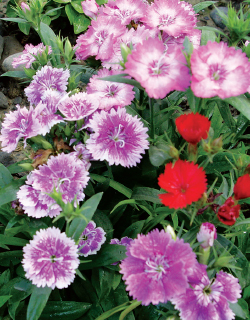
Fast-maturing species which has given rise to many garden series. The simple, narrow green leaves are all but hidden by the crop of brightly coloured flowers with pinked or serrated petals. Fine forms include the maroon and white ‘Black and White Minstrels’, brilliant red or white ‘Magic Charms’ and the pink or red ‘Victoriana’ series.
Soil preference: Any free-draining
Aspect: Sun
Season of interest: Summer
Height and spread: 30cm (1ft), variable by 20cm (8in)
Companion plants: Superb container plants, to blend with other summer flowers such as Lobelia erinus or with the foliage of Plectranthus and Glechoma hederacea ‘Variegata.’
Angelica gigas
Giant Angelica Hardy biennial or short-lived perennial
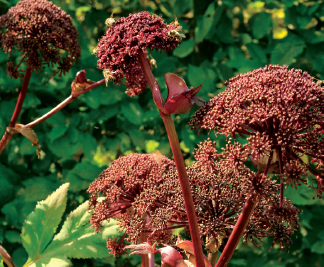
A big, clump-forming plant which may take two or three years to flower. The three-part leaves are large and green but carried on purplish stems. The flower buds form in dark, bulging sheaths and open to form attractive, purplish umbels. An East Asian plant of great character which, if happy, will self-seed.
Soil preference: Fertile, not too dry
Aspect: Sun or part shade
Season of interest: Spring, summer, autumn
Height and spread: 2m × 1m (6ft × 3ft)
Companion plants: A big monster to grow with lilies, perhaps, in semi-shade among shrubs, or to bring later interest in a woodland garden, perhaps among Fothergilla, magnolias, Enkianthus or to grow under wide-spaced trees in a large scale planting.
Brassica oleracea
Kale ‘Redbor’ Hardy biennial
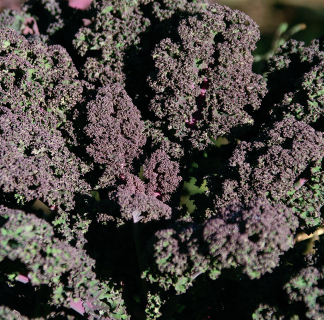
Purple curly kale. A decorative and edible member of the cabbage family with thick, erect stems and deeply creased and ruched leaves. The stem colour is bright rose purple, darkening to deep red-purple in the puckered leaves. In its second spring, pale yellow flowers are produced. Excellent for flavour, as well as ornament.
Soil preference: Any fertile, free-draining
Aspect: Sun
Season of interest: Summer, winter
Height and spread: 75cm × 45cm (2ft 6in × 1ft 6in)
Companion plants: Superb with the strong colours of late summer perennials such as chrysanthemums, rudbeckias, Mexican salvia spieces and with Swiss or Rhubarb chard.
Beta vulgaris
Chard Hardy biennial
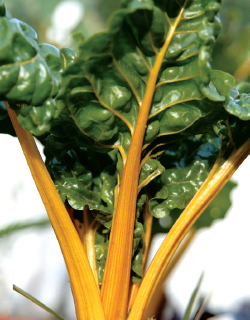
Usually grown as a vegetable, but a highly decorative plant. Huge, puckered leaves with thick midribs which may be coloured. When the plants bolt, coarse seedheads form and the ornamental and culinary value diminishes. Pretty varieties include ‘Bright Lights’ (red, white and yellow stems), ‘Lucullus’ (white stems) and ‘Charlotte’ (bright red stems with dark leaves).
Soil preference: Any
Aspect: Sun
Season of interest: Spring, summer
Height and spread: To 75cm × 30cm (2ft 6in × 1ft)
Companion plants: Lovely for an ornamental kitchen garden, or simply to mix in with a summer flower border to add substance and colour.
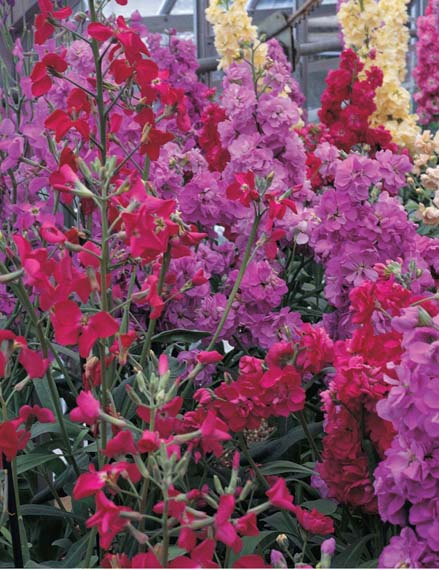
Pastel-coloured Brompton stocks (Matthiola incana) not only create attractive displays in any garden, but also attract bees with their powerful scent.
Planting Biennials for Spectacular Schemes
Biennials can be useful among more permanent flowering plants such as shrubs or perennials. Their temporary nature can be advantageous, enabling them to provide a spectacular show in their season, and then disappearing to leave an uncluttered space for the permanent plants to take over. Alternatively, they can be timed to complement their companion shrubs or perennials.
Spring-flowering biennials such as wall flowers or forget-me-nots are useful, not only for early colour, but also to relieve the monotony of deciduous shrubs or emerging perennials whose period of beauty is yet to come. They can be deployed as fillers, giving background colour to more brilliant performers such as tulips, or can be used to provide drifts of colour in their own right.
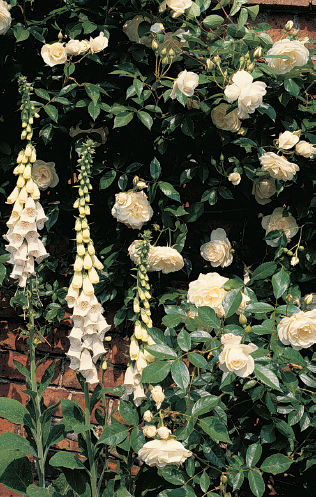
Although the same colour, the shape of Digitalis purpurea (foxglove) contrasts with that of the rose, ‘Climbing Iceberg’.
Stark contrast
The rose ‘Climbing Iceberg’ is teamed (below, left) by a white seedling foxglove, Digitalis purpurea. The colours harmonize, but the shapes and character of the plants are in stark contrast with each other. When the flowers of the foxglove are over, the whole plant can be pulled out or can be allowed to set seed for next year’s repeat show.
Informal air
A very loose, informal planting of climbing roses along an old limestone wall is enhanced by a drift of sweet Williams – Dianthus barbatus (below, right). The contrasting rose colours – ‘Scharlachglut’ (‘Scarlet Fire’) and ‘Gloire de Dijon’ – make a cheerful splash above the biennials, which help to draw the eye downwards and along the border. This is an early summer display but later, when the Dianthus are over, the scarlet rose will carry a conspicuous crop of orange hips, accompanied in the border by lilac-coloured colchicums.
Dual-purpose biennials
Some biennials are valuable as dual-purpose plants, creating attractive displays in beds or borders, or as cut flowers. In the main picture, opposite, these Brompton stocks have rich pastel colours and an intense fragrance, making them ideal for both purposes.
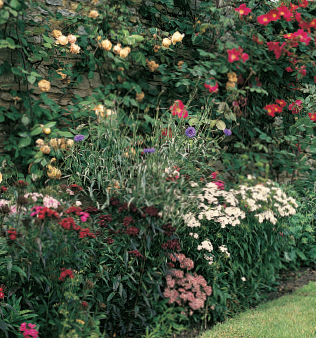
Sweet Williams, loosely planted in drifts, go well with roses up against a garden wall.

bedding
Bedding: spring flowering, full and dappled shade
Bedding: summer flowering, full sun
Bedding: summer flowering, dappled shade
Bedding for attracting wildlife
Bedding: spring flowering, full and dappled shade
Bellis perennis
Double Daisy, Lawn Daisy Perennial
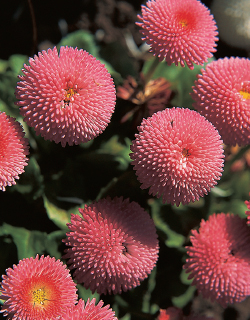
Rounded or spoon-shaped leaves create mats of foliage above which blooms are held on thin stems. The wild species has a golden flower centre, surrounded by white sterile florets whose edges are flushed pink. Garden varieties include the double ‘Pomponette’ series, pale pink ‘Dresden China’ and the reddish ‘Rob Roy’.
Soil preference: Any
Aspect: Sun or partial shade
Season of interest: Spring
Height and spread: Up to 15cm × 20cm (6in × 8in)
Companion plants: Beautiful when bedded with forget-me-nots and with such bulbs as hyacinths or tulips.
Hyacinthus orientalis
Hyacinth Bulb
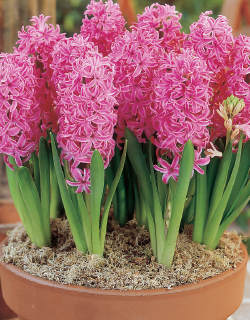
Fleshy, dark green leaves emerge in early spring. Later, chunky flower buds appear and extend to form thick flower spikes in shades of pink, blue, purple, white, pale yellow and orange. Intensely fragrant. ‘L’innocence’ is a fine bedding white, ‘Delft Blue’ is mid-blue, ‘Queen of the Blues’ darker and ‘Anna Marie’ pale pink.
Soil preference: Any free-draining
Aspect: Sun or shade
Season of interest: Spring
Height and spread: Up to 25cm × 15cm (10in × 6in)
Companion plants: Effective when bedded with winter pansies or polyanthus, but also superb when massed on their own. Fewer colours works better than a mix.
Viola
Winter Pansies Biennials or short-lived perennials

Low, mound-forming plants with diamond-shaped, slightly lobed leaves. The flowers, large in proportion to the plants, are flattened, disc-shaped, sweetly fragrant and almost perpetually in flower. Colours run through blue, orange, maroon, purple, yellow, pink and white. ‘Universal’ and ‘Ultima’ series are among the most popular winter flowering varieties. Deadhead to extend flowering.
Soil preference: Any well-drained, not too dry
Aspect: Part shade
Season of interest: Mainly winter but also year round
Height and spread: Approx 15cm × 20cm (6in × 8in)



